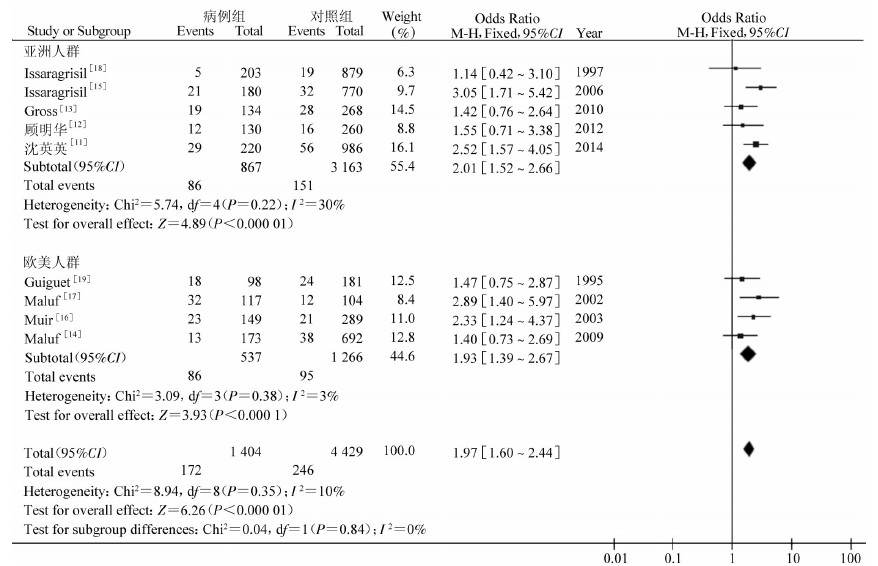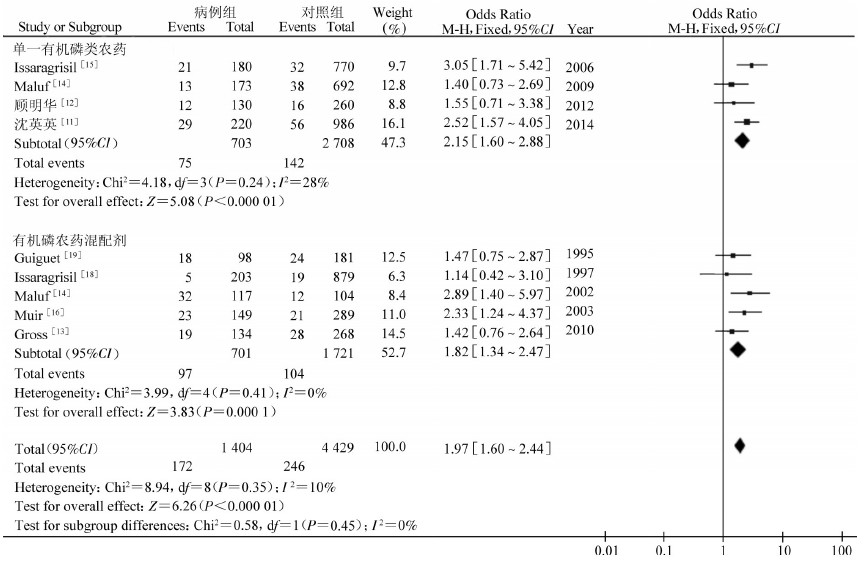文章信息
- 张骥, 杨土保.
- Zhang Ji, Yang Tubao.
- 有机磷农药与再生障碍性贫血发病关系的Meta分析
- Meta-analysis of association between organophosphorus pesticides and aplastic anemia
- 中华流行病学杂志, 2015, 36(9): 1005-1009
- Chinese Journal of Epidemiology, 2015, 36(9): 1005-1009
- http://dx.doi.org/10.3760/cma.j.issn.0254-6450.2015.09.021
-
文章历史
- 投稿日期: 2015-02-07
再生障碍性贫血(再障)是由多种原因引起骨髓微环境和骨髓造血干细胞受损,导致全血细胞减少的一种血液系统疾病。其临床主要表现为贫血、反复感染和出血。再障属罕见病,在人群中呈散发[1]。亚洲国家再障发病率(3.9/10万~5.0/10万)明显高于欧美国家(2.0/10万~2.7/10万)[2]。我国再障发病率为7.4/10万,各年龄组均有发病,尤以青壮年多见,男性发病率略高于女性[3]。再障因有严重的并发症而临床表现凶险,病死率较高的社会影响远超其较低的发病率[4],致使学者对其危险因素进行了大量研究[5, 6]。特别是有机磷农药与再障发病的报道,提示两者间可能存在关联[7, 8]。而20世纪90年代在欧洲和以色列开展的大型流行病学调查显示再障发病与药物、病毒感染密切相关,但与有机磷农药的关联不大[9]。随后的病因学研究中由于研究地域、人群不同,加之研究方法的差异,报道结果不尽相同[10],且缺乏大规模的流行病学研究结果,一直未能就有机磷农药与再障的关系形成共识。为此,本研究收集国内外相关研究资料进行Meta分析,以阐明两者间的关联,为其一级预防提供参考。
资料与方法1.资料来源:在中国生物医学文献数据库(CBM)、中国知网(CNKI)、PubMed及EMBASE中检索有关有机磷农药与再障发病关系的病例对照研究。检索年限为1990年1月至2014年8月,语种为英语和汉语。中文数据库以"再生障碍性贫血"、"再生不良性贫血"和"危险因素"、"病例对照研究"为关键词或者题名检索;英文数据库以"aplastic anemia AND "risk factors" ;"aplastic anemia "AND" casecontrol study"为自由词检索,根据检索结果调整检索策略,并辅以文献追溯方法对纳入研究的文献进一步分析。
2.文献纳入和排除标准:纳入标准包括①研究设计采用病例对照研究,明确提供病例及对照来源;②研究对象符合再障诊断标准并经医院确诊的患者,即全血细胞数减少,网织红细胞 < 1%,Hb < 100 g/L,血小板 < 50×109/L,中性粒细胞 < 1.5×109/L及骨髓多部位增生减少并活检显示造血组织减少;③提供病例组和对照组的观察人数、暴露因素的OR值及其95% CI (或通过数据可进一步计算OR值及其95% CI);④研究假设及方法相似,暴露定义基本一致(单一有机磷类农药包括一种或多种有机磷酸酯类农药;有机磷农药混配制剂是指有机磷酸酯类农药与氨基甲酸酯类农药、拟除虫菊酯类农药或其他类型农药的混合液);⑤病例组和对照组的基线数据具有可比性。排除标准包括研究设计存在缺陷,可靠性低,质量差;原始信息提供不全;重复报告及综述性文献。
3.质量评价和资料提取:使用Newcastle-Ottawa Scale (NOS)评价纳入文献。NOS采用星级系统的半量化原则,共包含3个方面评价:病例组与对照组的选择方法、可比性及暴露的评估方法。提取资料主要包括第一作者和发表年限、研究地点和期限、样本含量(病例组/对照组)及对照来源(医院人群/社区人群)。
4.统计学分析:利用Review Manager 5.0软件计算有机磷农药的合并OR值及其95% CI。采用Q检验和计算I2值分析异质性(Q检验,若P < 0.05,表明存在异质性;如I2 < 50%,表明各研究间异质性较小,选择固定效应模型进行分析,反之表明研究间异质性较大,选择随机效应模型对效应值进行合并)。对研究人群和有机磷农药的使用方式进行亚组分析,探讨可能的异质性来源,并进一步分析有机磷农药与再障的关系。通过比较固定效应模型与随机效应模型结果的一致性进行敏感性分析,评价研究结果的稳定性。潜在的发表偏倚采用失安全系数(Nfs)估计,Nfs值越大表明发表偏倚程度越低。
结果1.文献一般情况及质量评价:初检出相关文献183篇,排除重复及不符合纳入标准的文献,经筛选最终纳入文献9篇[11, 12, 13, 14, 15, 16, 17, 18, 19],其中英文7篇[13, 14, 15, 16, 17, 18, 19],中文2篇[11, 12],共计5 833例研究对象(其中病例组1 404例,对照组4 429例)。NOS文献评价结果显示文献评价总体质量较高(表 1)。
2.效应值的合并:对纳入的文献检验异质性,结果P=0.35,I2=10%,提示各研究间不存在明显的统计学异质性。采用固定效应模型分析,合并统计量:OR=1.97,95% CI:1.60~2.44,P < 0.000 1,差异有统计学意义(图 1)。
 |
| 图 1 有机磷农药与再障的Meta分析 |
3.亚组分析:对研究人群有机磷农药使用方式分别进行亚组分析,亚洲人群(I2=30%)的合并OR=2.01(95% CI:1.52~2.66),欧美人群(I2=3%)的合并OR=1.93(95% CI:1.39~2.67)(图 2)。有机磷农药使用方式的亚组分析显示,单一有机磷农药(I2=28%)的合并OR=2.15(95% CI:1.60~2.88),有机磷农药混配制剂(I2=0%)的合并OR=1.82(95% CI:1.34~2.47)(图 3)。
 |
| 图 2 研究人群与再障发病关系的亚组分析 |
 |
| 图 3 有机磷农药使用方式与再障发病的亚组分析 |
4.敏感性和发表偏倚分析:采用随机效应模型计算有机磷农药的合并OR=1.98(95% CI:1.58~2.49)与固定效应模型非常接近,表明研究结果的稳定性较好。计算Nfs0.05=107,结合漏斗图中各研究点分布较规则对称,可认为无显著发表偏倚。
讨论已有多项研究表明再障的发生与环境暴露有关[20]。流行病学资料显示苯类化合物、电离辐射、磺胺类药物是再障的危险因素,但有机磷农药与再障发病的关系则不明确[21]。有报道认为有机磷农药的长期、低剂量暴露与Hodgkin淋巴瘤、多发性骨髓瘤等血液系统肿瘤的发生有关[22]。Mahajan等[23]研究发现白血病的发病风险与有机磷农药暴露时间及剂量增加存在正相关。动物实验也表明有机磷农药可以通过损伤大鼠骨髓造血细胞和基质细胞群,导致骨髓功能衰竭和再障发生[24, 25]。本文合并9个病例对照研究结果,发现接触有机磷农药可使再障发病风险增加97%(OR=1.97,95% CI:1.60~2.44),提示有机磷农药可能是再障的危险因素,与国外研究结果基本一致[15, 16]。
本文显示亚洲人群(OR=2.01,95% CI:1.52~2.66)和欧美人群(OR=1.93,95% CI:1.39~2.67)接触有机磷农药均增加再障的发病风险,但前者的发病风险更高。可能是亚洲人群对有机磷农药的反应更敏感[26],也可能是亚洲地区,特别是以农业生产为主要经济来源的国家,有机磷农药的职业和环境暴露更频繁[27]。与以往的研究结果不同[28],本文有机磷农药使用方式的亚组分析发现,单一有机磷农药(OR=2.15,95% CI:1.60~2.88)比其混配剂(OR=1.82,95% CI:1.34~2.47)更易引发再障。因此,在日常生活中应减少使用单一有机磷农药。
本文存在局限性。虽然Meta分析中采用统一的纳入和排除标准选取原始文献并进行质量评价,但纳入研究类型均是病例对照研究,其病因推断能力不如队列研究,患者可能存在有机磷农药暴露史的回忆偏倚并影响研究结果;其次部分发表文献的原始数据不完整,分析时无法利用,一定程度上影响了结果的可靠性;由于大多数纳入研究未报道有机磷农药的暴露剂量,本文未分析有机磷农药的剂量-反应关系,故结果不够精准。因此有机磷农药与再障发病的真实联系还有待开展大样本高质量的前瞻性研究加以证实,而不同类型有机磷农药的暴露剂量、频率与再障的关系及有机磷农药与其他危险因素的交互作用将是今后研究的重点。
综上所述,虽然再障的发生是多因素的综合结果,但有机磷农药潜在的危害作用不容忽视,避免长期暴露于有机磷农药可有效降低再障的发病率。
| [1] Montané E, IbÁñez L, Vidal X, et al. Epidemiology of aplastic anemia:a prospective multicenter study[J]. Haematologica, 2008, 93(4):518-523. |
| [2] Fan R, Wang W, Wang XQ, et al. Incidence of adult acquired 图3 有机磷农药使用方式与再障发病的亚组分析 severe aplastic anemia was not increased in Shanghai, China[J]. Ann Hematol, 2011, 90(10):1239-1240. |
| [3] Lv LH, Gou ZR, Li P, et al. Study progress of aplastic anaenia[J]. Med Recap, 2011, 17(19):2944-2946. (in Chinese) 吕连华, 勾宗蓉, 李圃, 等. 再生障碍性贫血的研究进展[J]. 医学综述, 2011, 17(19):2944-2946. |
| [4] Sun WL, Zhao F, Zhang MH. A retrospective analysis on the onset of aplastic anemia patients hospitalized at hematology department of Qilu hospital of Shandong University in fifteen years[J]. J Shandong Univ:Health Sci, 2005, 43(9):814-817. (in Chinese) 孙婉玲, 赵芳, 张茂宏. 山东大学齐鲁医院血液科15年间再障患者发病情况的回顾性研究[J]. 山东大学学报:医学版, 2005, 43(9):814-817. |
| [5] Brodsky RA, Jones RJ. Aplastic anaemia[J]. Lancet, 2005, 365(9471):1647-1656. |
| [6] Biswajit H, Pratim PP, Kumar ST, et al. Aplastic anemia:a common hematological abnormality among peripheral pancytopenia[J]. N Am J Med Sci, 2012, 4(9):384-388. |
| [7] Lorand ICH, Souza CA, Costa FF. Haematological toxicity associated with agricultural chemicals in Brazil[J]. Lancet, 1984, 323(8373):404. |
| [8] Reeves JD, Driggers DA, Kiley VA. Household insecticide associated aplastic anaemia and acute leukaemia in children[J]. Lancet, 1981, 318(8241):300-301. |
| [9] Kelly JP, Kaufman DW, Shapiro S. Risks of agranulocytosis and aplastic anemia in relation to the use of cardiovascular drugs:The International Agranulocytosis and Aplastic Anemia Study[J]. Clin Pharmacol Ther, 1991, 49(3):330-341. |
| [10] Fleming LE, Timmeny W. Aplastic anemia and pesticides. An etiologic association?[J]. J Occup Med, 1993, 35(11):1106-1116. |
| [11] Shen YY, Chen Z, Lin SY, et al. A case-control study of multiple risk factors related to aplastic anemia[J]. J Clin Hematol, 2014, 27(4):564-569. (in Chinese) 沈英英, 陈智, 林圣云, 等. 再生障碍性贫血的多危险因素病例对照研究[J]. 临床血液学杂志, 2014, 27(4):564-569. |
| [12] Gu MH, Gao X, Zhu JY, et al. A case-control study on the risk factors of aplastic anemia in adult[J]. Chin J Ind Med, 2012, 25(2):87-90. (in Chinese) 顾明华, 高香, 朱静怡, 等. 成人再生障碍性贫血危险因素的病例-对照研究[J]. 中国工业医学杂志, 2012, 25(2):87-90. |
| [13] Gross SA, Irons RD, Schnatter AR, et al. A hospital-based case control study of aplastic anemia in Shanghai, China[J]. Chem Biol Interact, 2010, 184(1/2):165-173. |
| [14] Maluf E, Hamerschlak N, Cavalcanti AB, et al. Incidence and risk factors of aplastic anemia in Latin American countries:the LATIN case-control study[J]. Haematologica, 2009, 94(9):1220-1226. |
| [15] Issaragrisil S, Kaufman DW, Anderson T, et al. The epidemiology of aplastic anemia in Thailand[J]. Blood, 2006, 107(4):1299-1307. |
| [16] Muir KR, Chilvers CE, Harriss C, et al. The role of occupational and environmental exposures in the aetiology of acquired severe aplastic anaemia:a case control investigation[J]. Br J Haematol, 2003, 123(5):906-914. |
| [17] Maluf EMCP, Pasquini R, Eluf JN, et al. Aplastic anemia in Brazil:incidence and risk factors[J]. Am J Hematol, 2002, 71(4):268-274. |
| [18] Issaragrisil S, Chansung K, Kaufman DW, et al. Aplastic anemia in rural Thailand:its association with grain farming and agricultural pesticide exposure. Aplastic Anemia Study Group[J]. Am J Public Health, 1997, 87(9):1551-1554. |
| [19] Guiguet M, Baumelou E, Mary JY. A case-control study of aplastic anaemia:occupational exposures[J]. Int J Epidemiol, 1995, 24(5):993-999. |
| [20] Chen GB, Shao ZH, Chu YL. Epidemiological research status of aplastic anmia[J]. Chin J Hematol, 1999, 20(4):221-222. (in Chinese) 陈桂彬, 邵宗鸿, 储榆林. 再生障碍性贫血流行病学研究现状[J]. 中华血液学杂志, 1999, 20(4):221-222. |
| [21] Young NS, Kaufman DW. The epidemiology of acquired aplastic anemia[J]. Haematologica, 2008, 93(4):489-492. |
| [22] Bolognesi C. Genotoxicity of pesticides: a review of human biomonitoring studies[J]. Mutat Res, 2003, 543(3):251-272. |
| [23] Mahajan R, Blair A, Lynch CF, et al. Fonofos exposure and cancer incidence in the agricultural health study[J]. Environ Health Perspect, 2006, 114(12):1838-1842. |
| [24] Chatterjee S, Chaklader M, Basak P, et al. An animal model of chronic aplastic bone marrow failure following pesticide exposure in mice[J]. Int J Stem Cells, 2010, 3(1):54-62. |
| [25] Knospe WH, Husseini SG, Chiu KM, et al. Immunologically mediated aplastic anemia in mice:evidence of hematopoietic stromal injury and injury to hematopoietic stem cells[J]. Exp Hematol, 1994, 22(7):573-581. |
| [26] Bhalli JA, Khan QM, Haq MA, et al. Cytogenetic analysis of Pakistani individuals occupationally exposed to pesticides in a pesticide production industry[J]. Mutagenesis, 2006, 21(2):143-148. |
| [27] Issaragrisil S, Leaverton PE, Chansung K, et al. Regional patterns in the incidence of aplastic anemia in Thailand. The Aplastic Anemia Study Group[J]. Am J Hematol, 1999, 61(3):164-168. |
| [28] Kaufman DW, Issaragrisil S, Anderson T, et al. Use of household pesticides and the risk of aplastic anaemia in Thailand. The Aplastic Anemia Study Group[J]. Int J Epidemiol, 1997, 26(3):643-650. |
 2015, Vol. 36
2015, Vol. 36



